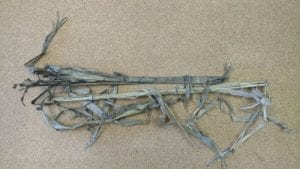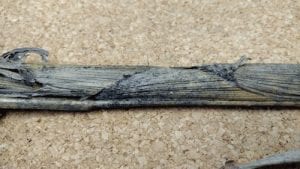By Sandy Johnson, Extension Beef Specialist, Colby, Steve Ensley, DVM, K-State Veterinary Diagnostic Lab, and John Holman, Agronomy, Garden City
In some areas of Kansas, summer moisture produced good tonnage of forage sorghum and other forages intended for winter livestock feeding. Heavy windrows extended drying time and some forage that was on the ground for weeks received both rain and snow. As a result, much of that forage had evidence of mold. In heavy windrows, the mold may have only been on the top and bottom of the windrow with the center well preserved. In other cases, and especially in thin windrows, the hay may be moldy throughout and the leaves and stalks nearly black. In some reports, mold was bad enough to turn equipment black during baling.
Does your feed contain mycotoxins?
The presence or absence of visible mold is not a reliable indicator of the presence or absence of mycotoxins. Very moldy feed may not contain any detectable amounts of known mycotoxins, while good looking feed may contain very high concentrations. Because forages do not contain the same level of carbohydrates as grains, they generally produce toxins less often.

Should you test for mycotoxins before feeding?
Determining if you should test for mycotoxins prior to feeding will be related to your relative aversion to risk and intended use. More than 800 mycotoxins have been detected but relatively few have been characterized and are considered important to animal health. Screening with ELISA kits or by black light are not always reliable and would need to be confirmed with a chemical analysis. A few labs such as the Veterinary Diagnostic Lab at Iowa State University can use a chemical analysis to screen for the most common mycotoxins.
Because mycotoxins are not evenly distributed in feeds, a through sampling job is needed. Collect a core sample from every ten bales, combine thoroughly, and mix cores samples before creating a one-pound subsample. Sampling in the windrow can be done but rather labor intensive (1 sample per 2.5 acres) to get a good representative sample. Freeze and ship with cold packs to prevent further mold growth during shipping.
Any moldy feed should not be fed to horses and minimized or avoided in pregnant cows. Sorghum or sundan feed is not recommend to be fed to horses as it can cause cystitis, which can result in death.
Sporadic mycotic abortions can occur in cows from the consumption of moldy feed. The mold can either be ingested or enter via the respiratory system. If the mold overwhelms the cow’s system it can eventually enter the placenta and cause the death of the fetus. Mold spores can also be harmful to people and result in something known as farmer’s lung. Repeated exposures increase the allergic reaction and subsequent tissue damage.
Grinding and mixing moldy hay with non-moldy hay would be a good way to utilize the forage. If you cannot grind this feed, consider palatability issues from both mold and forage maturity and how much will realistically be consumed. Grazing in the field eliminates baling and moving costs and rejected feed is left on the field. If fed free choice, expect sorting in the bunk and rejection of a portion of the feed.
Other issues to consider
Forage nutrient quality is also a concern from moisture received post-swathing. Respiration losses of highly digestible carbohydrates occur when forage moisture remains above 30%, and can continue if rain or snow prevents dry down. Rain or snow can cause leaching of nutrients, particularly if the forage is closer to baling when the moisture is received. Up to a 20% loss of digestible soluble nutrients such as carbohydrates, B vitamins, and potassium can occur. Nutrient detergent fiber (NDF) increases considerably in rained-on hay and intake would be expected to decrease accordingly. Nitrogen content, and thus crude protein, is minimally impacted by leaching. However, if the hay is baled wet and the temperature in the bale exceeds 120⁰ F, the heating can damage the digestibility of the protein. If baled a little wet (22-24% moisture) to hurry removal from the field, substantial spoilage and further loss of nutrients may result from the excessive heating and can allow for further mold growth.
To manage feed costs and ensure target animal performance when using this feed a nutrient analysis that includes crude protein, heat damaged protein and net energy or TDN should be conducted. Use this information to balance rations to meet needs.
Lastly, producers may encounter moldy plant or grain in the crop residue fields they plan to graze. The grain has more potential for the production of mycotoxins due to the carbohydrate content, but again, the presence of mold alone does not equal presence of mycotoxins. In most cases, cows grazing crop residues with some moldy grain has not caused health issues. When the total diet is considered, if mycotoxins are present, they are not likely to reach a concentration high enough to cause health issues. When feeding forage or grain of concern, the adage is “dilution is the solution”.
For more information on mycotoxins in general, see this link at Iowa State https://vetmed.iastate.edu/vdl/resources/client-services/pathogens/mycotoxins . Additional information on mycotic abortions is found in a news release on the topic at https://www.ksre.k-state.edu/news/stories/2016/03/mycotic-abortions030716.html.